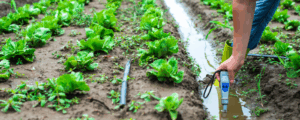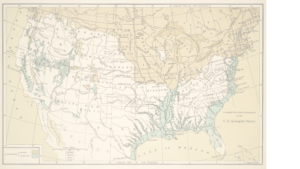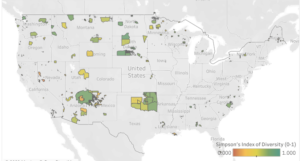Climate Planning Portal
Latest NLAP Climate News
Discover the latest climate related posts from the Native Lands Information System.

Understanding Wind Speed on Native Lands
Wind plays a significant role in shaping ecosystems, affecting infrastructure planning, and in overall renewable energy potential. Recognizing this, the Native Lands Advocacy Project (NLAP)

Creating a Historic Loss Assessment, Part 4: Extermination of buffalo and other significant losses
By calculating land dispossession, this report seeks to not only identify what has been taken from Native peoples but also how this theft became the original source of capital that built Colorado and the West.

New Storymap: Visualizing Federal Spending in Indian Country
Learn about three new data tools that allow users to access relevant data about federal investments in Indian Country.

The Impact Project Maps the Effects of Federal Changes on Local Communities
The Impact Project helps equip tribes with relevant information about the real-time effects of federal policy changes on local communities.

Creating a Historic Loss Assessment, Part 3: Illegal settlements and loss of agricultural revenue
By calculating land dispossession, this report seeks to not only identify what has been taken from Native peoples but also how this theft became the original source of capital that built Colorado and the West.

Introducing Our New Storymap: Water is Life: Native Efforts to Restore Water Systems
The Native peoples of North America have been caretakers of their lands and natural resources long before colonial contact, and they are the ones who

New to the NLIS? Start here!
The Native Lands Advocacy Project (NLAP) compiles, consolidates, and visualizes data resources to support sovereign, sustainable, Native-led land planning and protection.

We Remain Committed to Empowering Tribal Self-Determination & Data Sovereignty
The Native Lands Advocacy Project (NLAP) was founded in 2019 to provide much-needed data support to Native American communities. As a project of the nonprofit

These Water-Focused Data Tools Support Tribal Land & Climate Planning
The Native Land Information System (NLIS) is home to over 120 public, free data tools and resources that were created to support tribal communities in

Keystone Data Tools for Native Land Planning: View the webinar recordings & share your feedback
This month, the Native Lands Advocacy Project (NLAP) wrapped up our webinar series: Keystone Data Tools for Native Land Planning. These webinars introduced attendees to

Creating a Historic Loss Assessment, Part 2: Loss of life and Extraction of minerals
By calculating land dispossession, this report seeks to not only identify what has been taken from Native peoples but also how this theft became the original source of capital that built Colorado and the West.

Introducing the Climate Data Portal for U.S. Native Lands
The Native Lands Advocacy Project (NLAP) is thrilled to announce the launch of our Climate Data Portal for U.S. Native Lands! Developed with funding from

Check Out These Data Tools for Native Farmers & Ranchers
Native farmers and ranchers are major contributors to their reservation economies, food systems, and land stewardship. Recognizing this, NLAP has created dedicated pages of Data Tools for Native Farmers and Data Tools for Native Ranchers. Read more about these pages here.

Creating a Historic Loss Assessment, Part 1: Native history and land dispossession
By calculating land dispossession, this report seeks to not only identify what has been taken from Native peoples but also how this theft became the original source of capital that built Colorado and the West.

Introducing Our New Storymap: Good Fire: Mitigating Wildfire Risk & Healing Native Lands
The Native Lands Advocacy Project is happy to announce our newest storymap: Good Fire: Mitigating Wildfire Risk & Healing Native Lands!

New Data Tools for Fire Stewardship on Native Lands
The Native Lands Advocacy Project (NLAP) is excited to highlight three data tools related to fire on U.S. Native lands. These three tools (our Thermal

Introducing the Historic Loss Assessment: Articulating lost lives, land, and resources for the Native Nations in your state
While much of settler colonialism’s harm to Native Nations is unquantifiable, assessments like this provide data that helps tell those Nation’s stories.

Soil Organic Carbon Planning, Key to Building Tribal Climate Resiliency
As tribes continue to experience the impacts of climate change on their lands and communities, they are starting to invest more of their resources and planning strategies into protecting and enhancing their soil organic carbon (SOC).

Assessing Food Resilience on Native Reservations: the Good Food Access Indicator
NLAP’s Good Food Access Indicator (GFAI) helps Native communities challenge those who look at Native food systems through a deficit lens by creating a new way to measure food access on the reservation.

Crop Diversity on Native Lands
Our new Cropland Diversity data dashboard is the first index of Cropland Diversity ever calculated and published for US Native Lands. What findings does this dashboard reveal? And why does this data matter?
